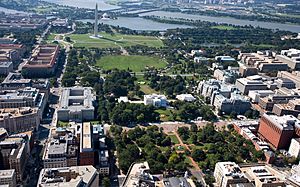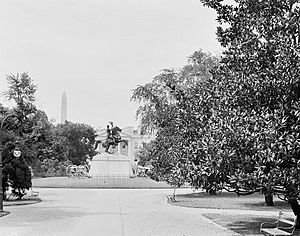Lafayette Square, Washington, D.C. facts for kids
Quick facts for kids Lafayette Square |
|
|---|---|

'Aerial view of Lafayette Square (foreground)
|
|
| Area | 7 acres (2.8 ha) |
Lafayette Square is a seven-acre public park in Washington, D.C., right in front of the White House. It's part of a bigger area called President's Park. The park is named after Gilbert du Motier, Marquis de Lafayette, a French hero who helped America win the American Revolutionary War.
You can find statues of many European heroes from the Revolutionary War here, including Lafayette himself. In the middle of the park is a famous statue of Andrew Jackson, an early U.S. president and general, riding a horse. In 1970, Lafayette Square and the buildings around it became known as the Lafayette Square Historic District.
Contents
How Lafayette Square Began
Lafayette Square was first planned as part of the beautiful grounds around the White House. This larger area, called President's Park, also includes the White House grounds and other important buildings.
In 1804, President Thomas Jefferson had Pennsylvania Avenue built through the park. This separated what would become Lafayette Square from the White House. In 1824, the park was officially named after the Marquis de Lafayette. He was a French general whose help was very important for America to win the American Revolutionary War.
The Decatur House, named after naval hero Commodore Steven Decatur, is next to Lafayette Square. This house is one of the few remaining examples of a place where enslaved people were bought and sold in a city.
Early Days of the Park

Before it became a park, the land where Lafayette Square now sits was used for many different things. It was once a racetrack, a graveyard, and even a zoo! Soldiers camped there during the War of 1812, and it was also a place for political protests and celebrations.
In the early and mid-1800s, many important people in Washington lived in homes around the square. These included Dolley Madison, Henry Clay, and John Hay.
In 1851, President Millard Fillmore asked Andrew Jackson Downing to design the landscape of Lafayette Square. He designed it in a "picturesque" style, which means it looked natural and beautiful.
Lafayette Square in the 20th Century
As the 1900s went on, fewer people lived around Lafayette Square. More buildings became offices for businesses and professional groups, especially in the 1920s.
The park's current design was created in the 1930s. Today, the park has five large statues. In the very center is the statue of President Andrew Jackson on his horse, which was put up in 1853. It was the first bronze statue ever made in the United States.
In the four corners of the park, you'll find statues of other foreign heroes from the Revolutionary War:
- Major General Marquis Gilbert de Lafayette (from France, installed 1891)
- Major General Comte Jean de Rochambeau (the comte de Rochambeau, from France, dedicated 1902)
- Brigadier General Thaddeus Kosciuszko (from Poland, dedicated 1910)
- Major General Friedrich Wilhelm von Steuben (the Baron von Stueben, from Prussia, dedicated 1910)
Squirrels in the Park
In the 1970s, Lafayette Square had a huge number of Eastern gray squirrels. There were so many that they damaged many trees and flowers in the park. People fed the squirrels too much, and the park service had even put up special boxes for them to nest in.
To solve this, in 1985 and 1987, the nest boxes were removed. Many squirrels were also caught and moved to other parks, like Fort Dupont Park. This helped the park's plants and flowers recover.
Peace Vigil
Thomas and Concepcion Picciotto started the White House Peace Vigil at Lafayette Square. This is the longest-running protest against nuclear weapons in U.S. history.
Protests in June 2020
In June 2020, many people gathered in Washington, D.C., and across the country to protest. These protests followed the death of George Floyd in Minneapolis.
On June 1, 2020, Lafayette Square was cleared of protesters and clergy members. This happened so that U.S. President Donald Trump could walk from the White House to St. John's Church for a photo. Many people felt that clearing the park this way was wrong and went against the right to gather peacefully.
See also
 In Spanish: Lafayette Square para niños
In Spanish: Lafayette Square para niños



